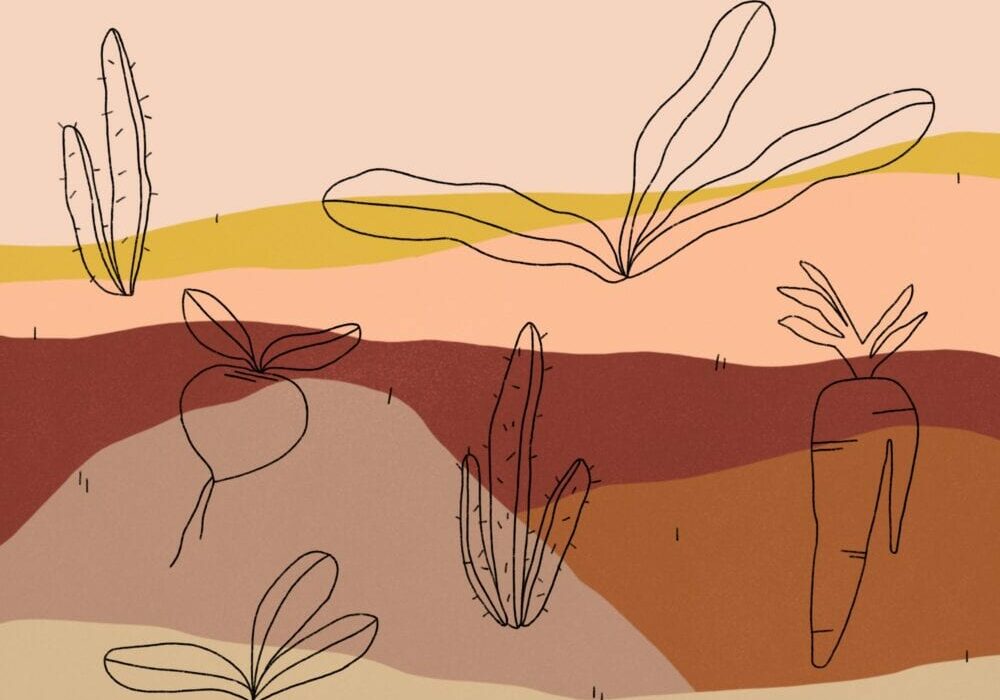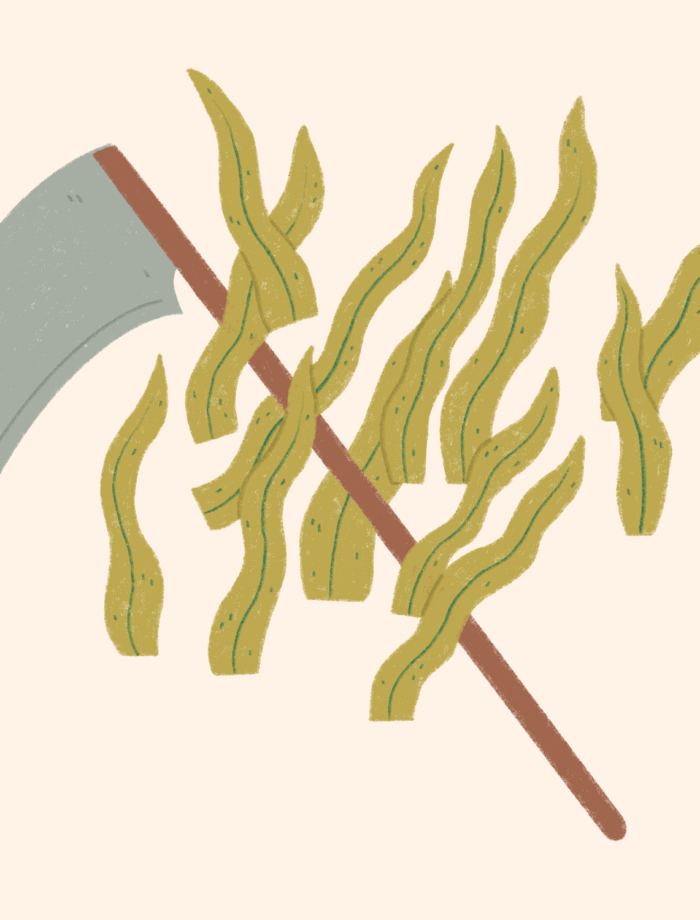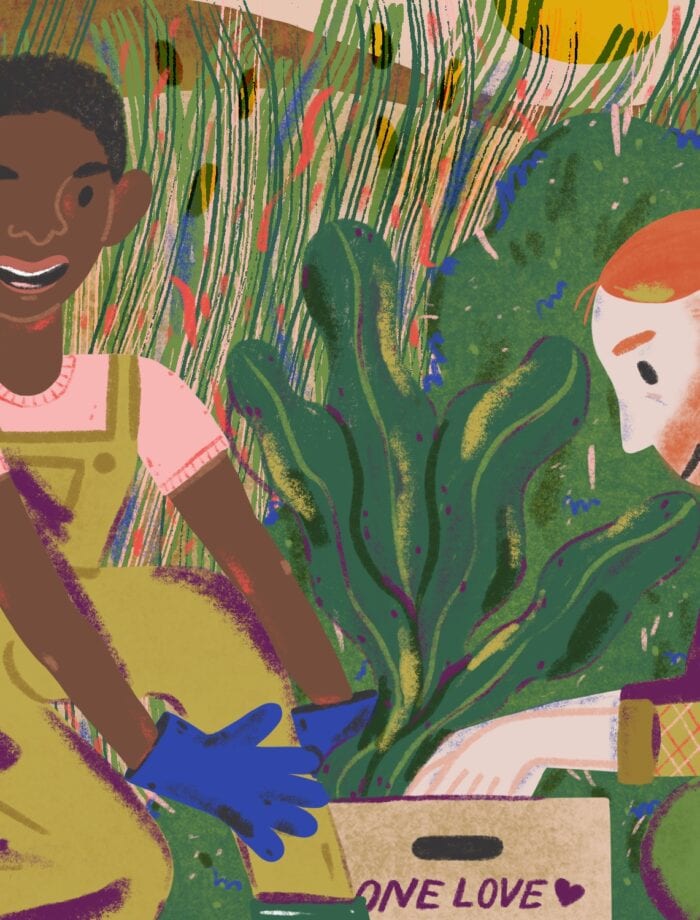Illustration by Hawnuh Lee.
We often villanize carbon dioxide, thinking of it as the enemy in our fight against climate change. But in doing so, we are forgetting the essential role it plays in our ecosystem. Plants need CO2 to photosynthesize, and almost all other organisms depend on the energy from this process to live. If you look at anything living or once living—from a tree branch, to a celery stalk, to your own body—you are looking at something that is storing lots of carbon. We associate CO2 with climate change because we have much more of it than we need in the atmosphere, trapping heat and raising global temperatures.
Right now, agriculture is one of the largest global emitters of CO2, but by shifting towards ‘carbon smart’ methods of farming, we’re seeing that it can play a crucial role in reversing atmospheric greenhouse gas levels. Carbon smart farming is a recently coined term for the practice of sustainable farming with an emphasis on carbon sequestration—storing large volumes of carbon in soil and organic matter. Scott Brainard, a tree crop analyst at the Savanna Institute, a nonprofit working to support agroforestry systems in the upper Midwest, is particularly interested in the role of perennial agriculture in this strategy. “There are many benefits to perennial agriculture, from diversifying agroecosystems away from a pure corn and soy rotation [in the Midwest], to reducing runoff and soil erosion,” he says. “But we’re focusing more and more on this aspect of specifically sequestering carbon.”
Carbon smart farming is a recently coined term for the practice of sustainable farming with an emphasis on carbon sequestration—storing large volumes of carbon in soil and organic matter.
Perennial crops are plants such as trees and shrubs that take a few years to start flowering, and then continue to do so year after year. All of the staple crops grown in the Midwest today are annuals—grains such and wheat, barley, and oats, and primary commodity crops—corn and soybeans. This means there is little to no permanent stable biomass where carbon is stored. A corn plant decomposes at the end of the growing season, releasing all of its carbon back into the atmosphere. Woody perennials, on the other hand, store carbon in their tissue for their entire lifespans, which can range from 10 to hundreds of years, and then continue to do so even after the plant dies.
Another way that perennial agriculture promotes carbon sequestration is through the soil itself. Research shows that there is more carbon stored in soil than in the atmosphere and all plant life combined. Returning atmospheric carbon back underground, and making sure it stays there, carries enormous potential as a climate change mitigation strategy. We’re looking at megatons of carbon sequestered per hectare of tree crop, according to Brainard.
Industrial farming operations tear up and turn over their fields every year to seed annual crops. “When we take modern heavy-duty tillage equipment and rip up that soil, we break open the soil profile and add oxygen to the mix, which leads to extremely rapid release of CO2 into the atmosphere,” Brainard says. “In a perennial agroforest, it’s pretty much impossible not to have an undisturbed soil system—you’ve got these trees growing on your land, you can’t be driving a plow through or you’ll kill them.”
The Future of Midwestern Farming Looks… Nutty?
So how might a perennial agroforestry system come to disrupt our nation’s great corn and soy belt? It turns out there are some promising perennial parallels that could supplant these reigning commodity crops. “We’re doing studies that compare the per acre oil yield of a hazelnut orchard to soybeans, and similarly, the starch yield per acre of a chestnut orchard to corn,” Brainard says. “From that perspective, we get a sense of whether these nut crops could replace corn and soybeans as commodities. And from that perspective, the answer is definitely yes—at maturity, those crops will outyield their annual counterpart.”
Unfortunately, the solution isn’t as simple as removing millions of acres of corn and soybeans and swapping them out for chestnuts and hazelnuts. “There’s a real financing problem associated with rolling these crops out at a large scale that stems from a delayed return on investment,” Brainard says. It takes anywhere from four years to a decade for shrubs and trees to start yielding crops at a profitable scale. Most farmers rely on a massive federal subsidy system that traps them into a cycle of debt and credit, making it impossible for them to survive years of waiting for return on investment. The Savanna Institute is currently working on a pilot hazelnut farm to demonstrate at-scale cash flow needs and profitability to help farmers get loans and show investors that perennial agroforestry is a cost-effective pursuit. “I don’t think there are many farmers who, if given lots of options, would choose to slowly go out of business growing corn and soybeans every year,” Brainard says. “But there aren’t a lot of options out there, and that’s the problem.”
The Mysterious Magic of Biochar
While the carbon storing capacity of woody materials is measured by magnitude of hundreds of years, biochar—a charcoal-like substance produced by burning organic matter in a low- or zero-oxygen environment—is estimated to maintain its stable carbon content for millennia. For this reason, many researchers are excited about its use in sustainable agriculture systems.
Kurt Spokas, a soil scientist at the USDA Agricultural Research Service, is researching how biochar could be added to soil for increased carbon sequestration and soil fertility. “The main advantage to biochar is the fact that it is a carbon form that is not utilized by the soil microbe community as a food source,” he explains. In other words, it takes longer to decompose than typical organic material in the soil—i.e. thousands of years, and potentially longer.
Small-scale and urban agriculture also acts as a meaningful way for city-dwellers to engage with the sustainable food movement.
The process of producing biochar is fairly simple. An amateur gardener could make it in a backyard pit or kiln, its only inputs being dry plant material and the know-how to create an anoxic burning environment. But how biochar stores carbon so dependably, and what other benefits it might afford to farmers, remains somewhat of a mystery. “Biochar is a very complex material chemically and physically,” Spokas Says. “Even though we have been actively researching this material for the last 10 years, we still do not have a complete understanding of all the mechanisms by which it accomplishes its magic.”
The ‘New Wave’ of Farmers
While loftier goals of mitigating climate change through carbon sequestration are focused on landscape-level changes to U.S. agriculture, small and local farming initiatives are still critical to the development of a sustainable food system. Natalie Woodcock, a farm apprentice at Windy City Harvest in Chicago, is part of what she calls the “new wave of farmers”—a group of agriculture enthusiasts and professionals who have dedicated their careers to environmentally conscious methods of growing food.
“Most of us are on the younger side and we’ve grown up seeing the travesties that industrial agriculture has caused,” she says. Her primary farm site is located on the southwest side Chicago, and is home to only one-eighth of an acre of production space, but thanks to a greenhouse, hoophouse, aquaponics system, and several outdoor growing beds, the garden is a consistent source of fresh fruits and vegetables for the local community.
Windy City Harvest and other urban farm initiatives prove that small-scale intensive horticulture is nothing to scoff at—though that’s the reaction Woodcock often receives from farmers she speaks to in the rural Midwest. “I think there is a communication deficit between the conventional farmers and this new generation,” she says, “I am interested in bridging that gap.”
Small-scale and urban agriculture also acts as a meaningful way for city-dwellers to engage with the sustainable food movement. These organizations provide hands-on experience to populations for which food systems education might not otherwise be accessible. When people are in touch with where food comes from and the resources it takes to grow, they are more likely to be invested in transitioning our larger systems to be more sustainable.
Of course, urban farms aren’t only seeking community participation for educational purposes. “We run on volunteers,” Woodcock says. She encourages anyone interested in getting their hands in the soil to research local farm and garden projects, and commit to showing up on a regular basis. “Farmers really value those volunteers that come out consistently because they can train them once and then continuously develop skills,” she says.
With so many systemic barriers in place to achieving a carbon smart future for farming in the U.S., it may seem like an unrealistic goal. But Brainard is confident that he and his colleagues, and of course the farmers on the frontlines of the movement, are making real change.
There is a communication deficit between the conventional farmers and this new generation.
“It can be daunting, but we are following in the footsteps of farmers, and taking our cues from the needs of this nascent industry,” he says. “There are visionaries in this field [a handful of which can be found on the Savanna Institute’s ‘Highlighted Mentor Famers’ page], and it’s farmers like them that are the reason I feel like this might actually work.”
If you are interested in supporting sustainable agriculture in the Midwest, the Savanna Institute accepts one-time and monthly donations on their website, and Windy City Harvest’s parent organization, the Chicago Botanic Gardens, accepts donations to support the program.
Wherever you are in the country, volunteering at a local farm or community garden, supporting local farmers, shopping at farmer’s markets, and getting curious about how and where your food is grown, are all ways you can actively facilitate a smarter future for our food system.
This piece was originally written and published for Replate Blog. Check em out!




